SHINYO!
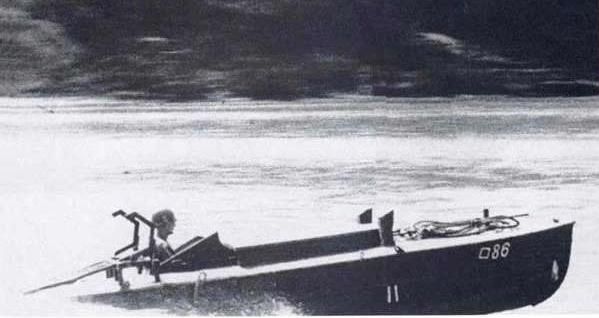 (Captured EMB under test by an American
soldier)
(Captured EMB under test by an American
soldier)
Explosive Motorboats based
on Formosa (Taiwan) and the Pescadore Islands,
1944-1945
© 2011 Bob Hackett and Sander Kingsepp
Revision 1
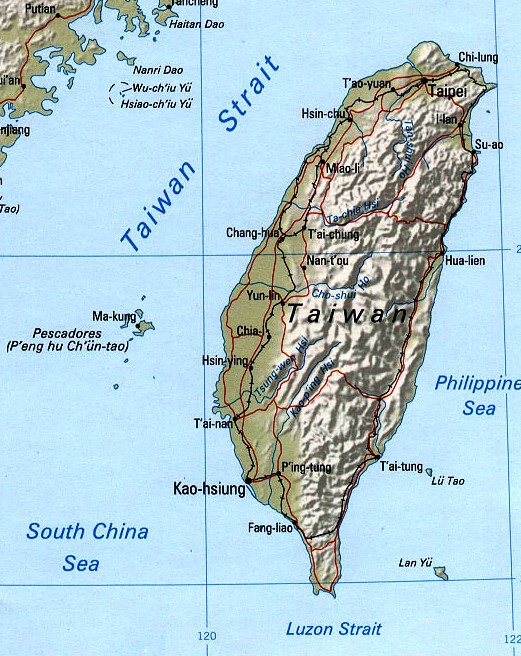 Formosa and the Pescadores
500 A.D.:
Formosa and the Pescadores
500 A.D.:
Significant migration from the Chinese mainland begins. The original Chinese name of the island is Taiwan, called Formosa by the west from the 16th century,
1279-1368:
During the Yuan dynasty, the Mongols occupy the Penghu Islands, also known as the Pescadores. Later, the Pescadores are also ruled by Dutch, Chinese and Japanese.
1624:
Dutch traders claim Taiwan as a base for commerce with Japan and China. In 1626, the Spanish establish a settlement on the northwest coast until 1642 when they are driven out by the Dutch.
1662:
The Ming Dynasty, which lost control of mainland China in 1644, defeats the Dutch and establishes a base of operations on the island until defeated by the Ching Dynasty in 1683.
17 April 1895: Treaty of Shimonoseki:
Following the Ching Dynasty’s defeat by the Imperial Japanese Army (IJA) in the First Sino-Japanese War of 1894, China cedes sovereignty over Taiwan. Shortly thereafter, Taiwanese declare the formation of the Taiwan Republic, but the IJA soon crushes the movement. During the next half century, Taiwan is an integral part of the Empire of Japan.
25 November 1943: The Cairo Conference:
In the Cairo Declaration, the United States, United Kingdom, and China state it to be their purpose that "all the territories that Japan has stolen from the Chinese, such as Formosa and The Pescadores, shall be restored to the Republic of China."
 Chiang Kai-shek, Franklin D. Roosevelt, and Winston Churchill at the Cairo Conference
1943-1944:
Chiang Kai-shek, Franklin D. Roosevelt, and Winston Churchill at the Cairo Conference
1943-1944:
Discussions between the War (Army) and Navy Departments are divided as to bypassing the Philippines and first invading Formosa. Admiral Ernest J. King (USNA ’01), Chief of Naval Operations and Navy member of the Joint Chiefs of Staff, strongly advocates bypassing the Philippines. King’s view is the seizure of Luzon before Formosa will delay execution of more decisive operations to the north. He also argues that capture of Formosa will greatly facilitate the subsequent occupation of Luzon.
In the Pacific, General Douglas MacArthur is equally adamant against bypassing any part of the Philippines. MacArthur’s view is that Luzon is a more valuable strategic prize than Formosa. He declares that the Allies will need to reoccupy the entire Philippine Archipelago before they can completely sever Japan's lines of communication to the south. MacArthur also argues that an invasion of Formosa will prove unduly hazardous without air and logistical support from Luzon.
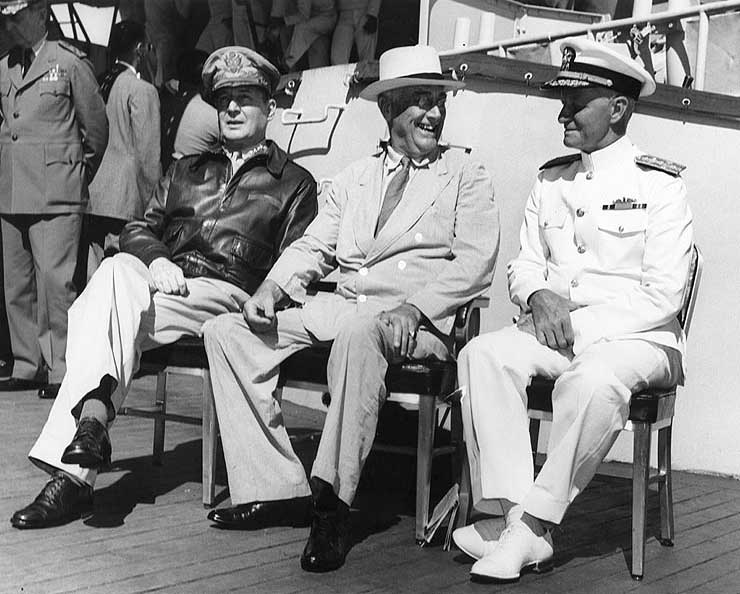 General MacArthur, President Roosevelt and Admiral Nimitz aboard USS BALTIMORE
26 July 1944:
General MacArthur, President Roosevelt and Admiral Nimitz aboard USS BALTIMORE
26 July 1944:
Pearl Harbor, Honolulu, Hawaii. President Franklin D. Roosevelt arrives aboard USS BALTIMORE (CA-68) to meet with his two Pacific commanders, Admiral Chester Nimitz (USNA ‘05) and General MacArthur. At the Waikiki home of businessman Christian Holmes, Roosevelt hears Nimitz and MacArthur present the "Luzon versus Formosa" arguments. MacArthur argues persuasively that it is both necessary and proper to take Luzon before going on to Formosa, while Nimitz explains the Navy plan for striking straight across the western Pacific to Formosa, bypassing Luzon. At the end of the meeting, Roosevelt declares in favor of MacArthur's return to the Philippines.
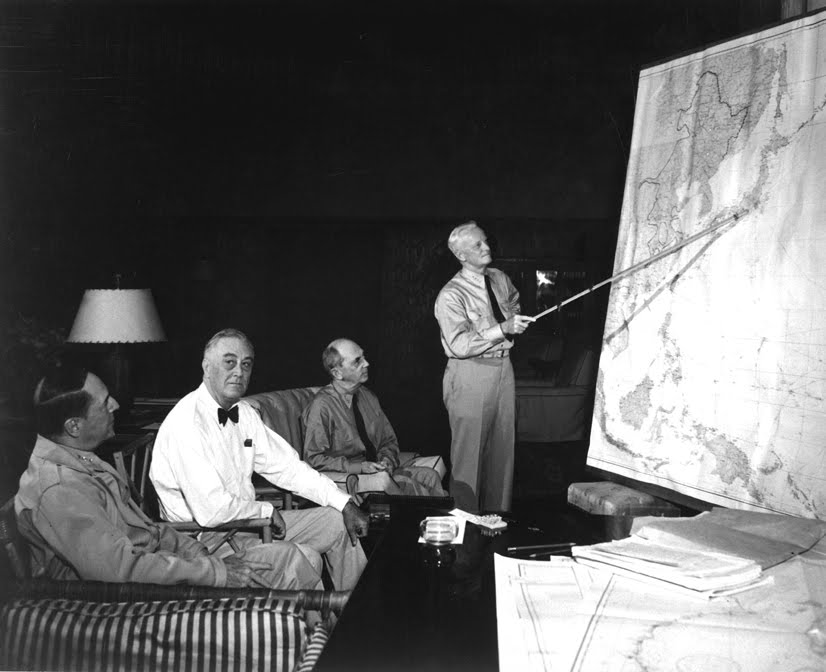 Admiral Nimitz explains Admiral King's Formosa-first plan to Roosevelt,
Admiral Nimitz explains Admiral King's Formosa-first plan to Roosevelt,
while General MacArthur and Admiral Leahy listen
The plan, as later formulated, calls for MacArthur's forces to attack Mindanao, Philippines and those forces under Nimitz to strike the island of Yap. The two forces will then be combined to assault Leyte. MacArthur's forces will next invade Luzon, after which Nimitz's forces will move against Iwo Jima and Okinawa.
20 October 1944:
The 20th Shinyo Squadron is organized with an authorized strength of 50 Type 1 Shinyo Explosive Motorboats (EMB) and 184 men. Lt (j.g.) Susuki is the Commanding Officer.
That same day, the 21st Shinyo Squadron is formed with 55 Type 1 EMBs and 183 men. Lt (j.g.) Takeuchi Izumi is the CO. The IJN plans to base both units in southern Formosa near the large port of Takao (Kaohsiung). [1]
5 November 1944:
The 24th Shinyo Squadron is organized with a strength of 68 Type 1 EMBs and 184 men. Lt (j.g.) Wakamatsu Rokuro is the CO. That same day, the 25th Shinyo Squadron is formed organized with 50 Type 1 EMBs and 183 men. Lt (j.g.) Wada Kyozo is the 25th's CO. The IJN plans to base both the 24th and 25th Shinyo Squadrons in the Pescadores, near the large port of Makung (Mako).
10 November 1944:
Convoy MOMA-07 departs Miike, Kyushu for Manila consisting of MIHO, GYOKUYO, MIHO, KENJO, NARUO, JINYO, FUKUYO, TATSUAKI (TATSUSHO), SHIROUMA (HAKUBA) and SHINFUKU MARUs and MINO MARU and KONAN MARU No. 1 escorted by kaibokan CD-8, CD-9, CD-28 and CD-54 auxiliary subchaser CHa-24 and an unidentified warship.
MIHO MARU is carrying men and explosive motor boats (EMBs) of the 20th Shinyo Squadron to be based at Takao, Formosa.
11 November 1944:
Near Cape Ose Sea, Goto Archipelago. At 0906, Cdr (later Rear Admiral-Ret) Charles E. Loughlin’s (USNA ‘33)USS QUEENFISH (SS-393) fires four torpedoes and hits MIHO MARU in the bow. Unable to keep up with the convoy, she heads for Sasebo. Nine men of the 20th Shinyo Squadron may have been KIA.
14 November 1944:
Convoy HI-81 departs Imari Bay for Singapore consisting of IJA landing craft depot ships AKITSU, MAYASAN, KIBITSU and SHINSHU MARUs, tankers MIRI, ARITA, HASHIDATE, TOA and OTOWASAN MARUs and transport (ex-seaplane tender) KIYOKAWA MARU escorted by carrier SHINYO, destroyer KASHI and kaibokan ETOROFU (F), TSUSHIMA, DAITO, KUME, SHONAN (SYONAN), CD-9 and CD-61. The convoy carries about 4,500 men of the IJA’s 23rd Infantry Division being deployed to the Philippines.
Among AKITSU MARU’s troops and other cargo, she carries the IJA’s 20th Sea Raiding Battalion with 104 “Maru-ni” explosive motor boats (EMB). MAYASAN MARU also carries the 24th Sea Raiding Battalion with an unknown number of “Maru-Ni” EMBs.
15 November 1944:
At 1155, LtCdr (later Rear Admiral) Charles E. Loughlin's USS QUEENFISH (SS-393) fires four stern torpedoes and gets two hits that sink AKITSU MARU at 33-17N, 128-11E. One of the torpedoes sets off AKITSU MARU’s aft magazine holding depth charges to be carried by the “Maru-ni” aboard. Induced explosions shatter the aft portion of the ship. As the seas hit her boilers, they explode. In three minutes, she capsizes to port and takes down 2,246 crew and men. Over the next twenty-four hours, the escorts rescue 310 survivors
That same day, Lt (j.g.) Nagai's 29th Shinyo Squadron is organized with with 54 Type 1 EMBs and 191 men and the 31st Shinyo Squadron is formed with 55 Type 1 EMBs and 187 men. The IJN plans to base both of these units near the large port of Takao in southern Formosa.
17 November 1944:
At 1815, LtCdr (later Cdr) Evan T. Shepard’s (USNA ‘35) USS PICUDA (SS-382) attacks convoy HI-81. PICUDA torpedoes and sinks MAYASAN MARU in rising seas at 33-17N, 124-41E. She sinks in two and a half minutes taking down 3,536 crew, troops, 204 horses and the IJA’s 24th Sea Raiding Battalion’s “Maru-Ni” EMB. The escorts rescue about 1,300 men.
30 November 1944:
At 0900, convoy MI-29 departs Moji for Miri, Borneo via Manila consisting of tankers ENGEN, ENCHO, ENKEI and SHINYU MARUs and transports AKIKAWA, AKISHIMA, BRAZIL, CLYDE, HAWAII, MEIRYU, ENOURA, DAII, and KAZUURA MARUs, HOSHI MARU No. 11 and KONAN MARU No. 1 escorted by destroyer ASAGAO, kaibokan IKUNA, SHINNAN, KANJU, CD-41, CD-66, subchaser CH-28 and auxiliary subchaser CHa-223.
Among HAWAII MARU’s troops and other cargo, she carries the 22nd Sea Raiding Battalion and its base battalion and 60 “Maru-ni” EMBs.
2 December 1944:
At about 0400, LtCdr (later Cdr) Ralph C. Style's (USNA '33) USS SEA DEVIL (SS-400) fires four torpedoes and gets one hit in HAWAII MARU’s No. 2 hold's cargo of ammunition and a series of explosions occur that set the ship afire. The flames spread to No. 4 hold where gasoline is stowed and huge explosion occurs, HAWAII MARU immediately sinks at 30-16N 135-48E. All 1,843 soldiers and crew aboard are KIA. The 22nd Sea Raiding Battalion loses five officers, 24 NCOs and 6 enlisted men. Later, two more men later die in a Taiwan hospital. Also lost are all 60 suicide boats and 50 men of the 22nd's Sea Raiding Battalion's maintenance company (seibi chutai). The Battalion is considered annihilated (zenmetsu).
8 January 1945:
The 43th Shinyo Squadron is organized under Lt (j.g.) Sato with 52 Type 1 EMBs EMB and 167 men. The IJN plans to base the 43th Shinyo Squadron in Formosa; but it is lost at sea on an unknown date to unknown causes. All 167 men are lost. The squadron is dissolved.
The 101st Shinyo Squadron is formed under Lt (j.g.) Sato with 25 authorized strength of 26 Type 5 EMBs and 183 men; but it is lost at sea on an unknown date to unknown causes. 163 of its men are lost.
That same day, the 105th Shinyo Squadron is organized with an authorized strength of 28 Type 5 EMBs and 186 men. Lt (j.g.) Yokota is the CO. The IJN bases the 105th Shinyo Squadron in the Pescadores, near Makung.
26 January 1945:
At 0800, convoy HI-91 departs Moji via Sasebo and Takao for Singapore consisting of auxiliary Navy transport (ex-seaplane tender) SANUKI MARU, transport KITSURIN MARU and tankers TOJO and EIYO MARUs escorted by destroyers NOKAZE and KAMIKAZE and kaibokan SHONAN, KUME, CD-25 and CD-53.
SANUKI MARU, bound for Takao, is carrying 52 Type 1 EMBs and 167 men of the 43rd Shinyo Squadron, as well as 26 Type 5 EMBs and 183 men of the 101st Shinyo Squadron.
28 January 1945:
Yellow Sea. NE of Shanghai, China, off Kokuzan To. Cdr (later Captain) Gordon W. Underwood’s (USNA ‘32) USS SPADEFISH (SS-111) makes contact with a three-ship convoy and four escorts. At 0313, Underwood fires three torpedoes that hit and sink SANUKI MARU at 33-55N, 122-55E. She takes down all 78 EMBs and all of the 43rd Shinyo Squadron's men and but 20 men of the 101st Shinyo Squadron.
Underwood also torpedoes and sinks kaibokan KUME. Destroyers KAMIKAZE and NOKAZE, probably laden with survivors, are detached from the convoy to Mako, Pescadores.
 USS SPADEFISH at Mare Island Navy Yard, 1944
15 August 1945: Cessation of Hostilities:
USS SPADEFISH at Mare Island Navy Yard, 1944
15 August 1945: Cessation of Hostilities:
Imperial Palace, Tokyo. At noon, the Emperor announces Japan's surrender that is broadcast by radio all over the Japanese Empire.
During the course of the war, in addition to the losses at sea of the men previously mentioned, the 25th Shinyo Squadron looses 44 men, the 28th Shinyo Squadron looses 3 men and the 105th Shinyo Squadron looses two men, all to unknown causes.
2 September 1945:
Tokyo Bay. The Japanese formally surrender to the Allies by signing the Instrument of Surrender aboard the USS MISSOURI (BB-63). Immediately following the signing ceremony, General of the Army Douglas MacArthur, Supreme Commander for the Allied Powers (SCAP), issues General Order No. 1 for the surrender of Japanese forces. It assigns responsibility for demobilizing Japanese forces in China, Indochina and Formosa to Generalissimo Chiang Kai-shek.
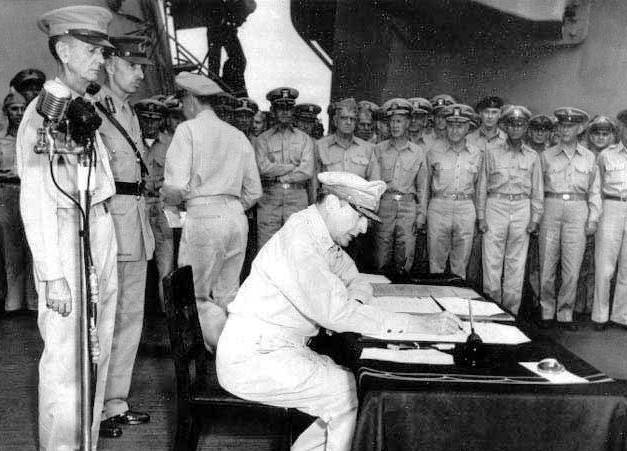 General MacArthur signs the Allied Powers Instrument of Surrender
General MacArthur signs the Allied Powers Instrument of Surrender
aboard USS MISSOURI in Tokyo Wan
25 October 1945:
Taipei City Hall. The last Japanese governor of Formosa, General Ando Rikichi, formally surrenders Formosa to Chinese General Chen Yi General in accordance with General MacArthur's General Order No. 1. [2]
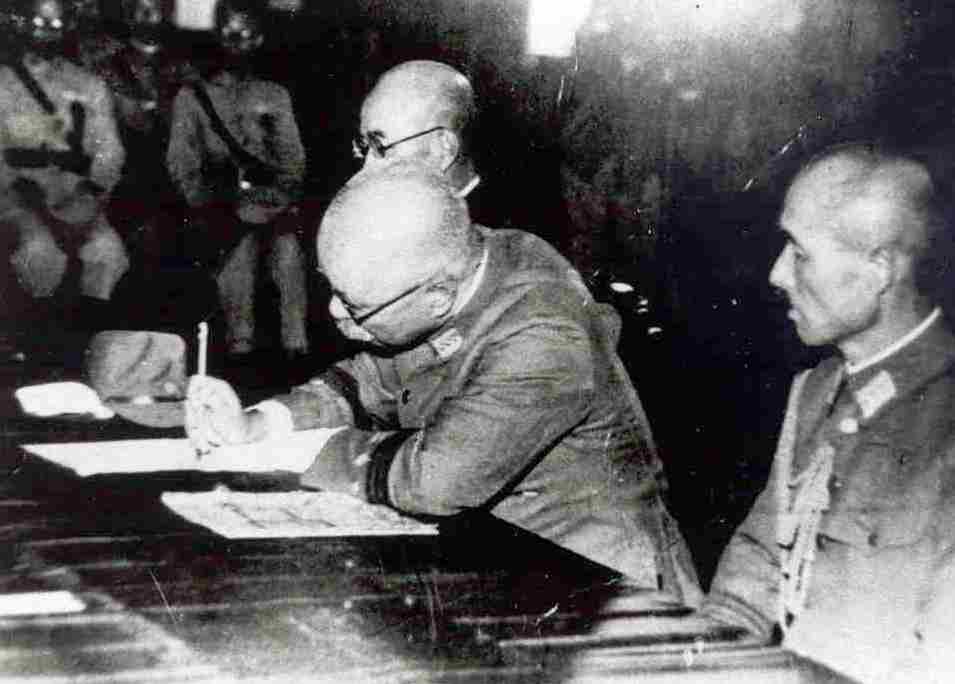 Ando signs the document of surrender
Ando signs the document of surrender
Author's Notes:
[1] A typical Shinyo Squadron had 183 members in total including 8 officers, 53 motorboat pilots, 14 headquarters personnel, 73 base workers
and 35 maintenance personnel.
[2] Postwar, Ando was arrested by Chinese authorities for war crimes from his tenure as C-in-C of the IJA 21st Army in China. Ando committed suicide in Shanghai while in prison before he could come to trial.
Chinese General Chen Yi returned to the Mainland, but in 1949 Chiang Kai-shek had him arrested for collaboration with the Communists. Later, he was executed on Taiwan.
Thanks go to Akira Takizawa of Japan and Erich Mueththaler of Germany.
-Bob Hackett and Sander Kingsepp
Back to Explosive
Motorboats Page












